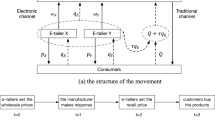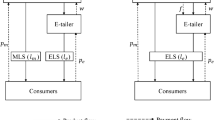Abstract
Together with regular retail channel, a firm can distribute products directly through Internet (referred to as an “e-tail” distribution channel). The competitive edge of the retail channel lies in more value-added services, some of which are unavailable through the e-tail channel. We consider a model mixed with retailing and e-tailing distribution channels where the service level and price decision are made, respectively, ex ante and ex post demand realizations. From the firm’s perspective of managing the two channels, we acquire the optimal decisions and characterize the effects of the demand uncertainty on the firm’s optimal retail service and expected profit. Applying stochastic comparison method, we show the firm’s retail service and profit both increase in the demand mean, and the firm profits from the increase of the convex order of the demand by decreasing his service level. Further, if the coefficient of the demand increases, we characterize that the firm benefits from it. Finally, several numerical studies are presented to gain insights.
Similar content being viewed by others
References
Chen, K. Y., Kaya, M., & Özer, Ö. (2008). Dual sales channel management with service competition. Manufacturing and Service Operations Management, 10(4), 654–675.
Chiang, W. K., & Monahan, G. E. (2005). Managing inventories in a two-echelon dual-channel supply chain. European Journal of Operational Research, 162, 325–341.
Chiang, W. K., Chhajed, D., & Hess, J. D. (2003). Direct marketing, indirect profits: a strategic analysis of dual-channel supply chain design. Management Science, 49(1), 1–20.
Chod, J., & Rudi, N. (2005). Resource flexibility with responsive pricing. Operations Research, 53(3), 532–548.
Chu, W., Gerstner, E., & Hess, J. (1998). Dissatisfaction management with opportunistic consumers. Journal of Service Research, 1(2), 140–155.
Devaraj, S., Fan, M., & Kohli, R. (2002). Antecedents of B2C channel satisfaction and preference: Validating E-commerce metrics. Information Systems Research, 13(3), 316–333.
Dumrongsiri, A., Fan, M., Jain, A., & Moinzadeh, K. (2008). A supply chain model with direct and retail channel. European Journal of Operational Research, 187, 691–718.
Fay, C. J. (1999). The direct approach. Best’s Review, 99(11), 91–93.
Meyer, J. (2010). Representing risk preferences in expected utility based decision models. Annals of Operation Research, 176, 179–190.
Müller, A., & Stoyan, N. (2002). Comparison methods for stochastic models and risks. Chichester: Wiley.
Rohm, A. J., & Swaminathan, V. (2004). A typology of online shoppers based on shopping motivations. Journal of Business Research, 57, 748–757.
Samuelson, N. (1998). Economics. New York: McGraw-Hill.
Seifert, R. W., Thoneman, U. W., & Sieke, M. A. (2006). Relaxing channel separation-integrating a virtual store into the supply chain. IIE Transactions, 38, 917–931.
Sundarraj, R. P. (2006). A model for standardizing human decisions concerning service-contracts management. Annals of Operation Research, 143, 171–189.
Tedeschi, B. (2000). Compressed data; big companies go slowly in devising net strategy. New York Times (March 27).
Tsay, A. A., & Agrawal, N. (2000). Channel dynamics under price and service competition. Manufacturing and Service Operations Management, 2, 372–391.
Vaz, C. B., Camanho, A. S., & Guimarães, R. C. (2010). The assessment of retailing efficiency using network data envelopment analysis. Annals of Operation Research, 173, 5–24.
Yan, R. L., & Pei, Z. (2009). Retail services and firm profit in a dual-channel market. Journal of Retailing and Consumer Services, 16(4), 306–314.
Yao, D. Q., & Liu, J. (2005). Competitive pricing of mixed retail and e-tail distribution channels. Omega, 33, 235–247.
Yao, D. Q., Yue, X., Mukhopadhyay, S., & Wang, Z. P. (2009). Strategic inventory deployment for retail and E-tail stores. Omega, 37, 646–658.
Author information
Authors and Affiliations
Corresponding author
Rights and permissions
About this article
Cite this article
Hu, W., Li, Y. Retail service for mixed retail and E-tail channels. Ann Oper Res 192, 151–171 (2012). https://doi.org/10.1007/s10479-010-0818-7
Published:
Issue Date:
DOI: https://doi.org/10.1007/s10479-010-0818-7




